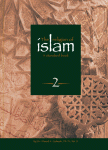The Religion Of Islam vol.2

How the Prayer Service is Performed
At the time of public prayer, as stated before, the muezzin or crier ascends the minaret or stands at the side of the mosque nearest to the public thoroughfare, and gives the azân or the call to prayer, as follows:-
1. God is Greater (twice).
2. I bear witness that there is no deity but Allah (twice).
3. I bear witness that Muhammad is the Apostle of God (twice).
4. Come to prayer (O ye Muslims) (twice).
5. Come to salvation and prosperity (twice).
6. God is Greater (twice).
7. There is no deity but Allah.
In the early morning, the following “cry” is added: “Really prayers are better than sleep”(twice).
When the prayers are said privately, in a congregation or in the mosque, they begin with the iqâma, which is the second call to the salât, with the addition of the sentence “Prayers are now ready (twice)”. The regular form of prayer then begins with the niyya, i.e. the worshipper’s intention, expressed (better by heart) that he
|
|
|
Fig. 1. – The niyya posture Fig. 2. – The takbirât el-ihrâm posture
Purposes to offer up to God such rak’âts ([1]) as the case may be, while standing up with the face qibla-wards, i.e. towards Mecca. The Arabic expression is as follows (see Fig. 1):-
“Nawayto osalli rak’atyn fares-sobhi” (or thalâtha or arba’a rak’âts if the maghrib or ‘asr or ‘isha is concerned). (Transliteration)
I propose to perform to God two or three or four Rakaats as the case may be.
1- Then follow the words of “takbirât-el-ihrâm”: Allâhu Akbar “God is Greater”, uttered with the thumbs touching the lobules of the ears and the open hands on each side of the face, as shown in Fig. 2.
2- Then comes the qiyâm position: The right hand is placed upon the left over the breast while the standing position is maintained, the eyes looking to the ground in self-abasement (see Fig. 3).
During this posture, the worshipper recites the following tasbih or supplication:-
“Subhânaka Allâhumma wa be hamdika wa tabâraka ismuka wa ta’âla judduke wa lâ Ilâha ghayruk. A’ôzu billâhi minashshaytânir-rajîm.” (Transliteration)
“Glory to Thee O Allah (God) and Thine is the praise, and blessed is Thy name and exalted is Thy majesty; there is no deity to be worshipped but Thee. I seek Allah’s protection against the cursed Satan” (temptation). (Translation)
 |
Fig. 3. – Qiyâm position
After this, the Fâtiha (the Opening Chapter of the Koran) is recited in the same position. It runs as follows:-
“Bismillâhir-rahmânir-rahim, al hamdu lilâhi-rabbil-‘âlamîn, ar-rahmânir-rahîm, mâliki-yawmiddîn, iyyâka na’bodu we iyyâka nast’în, ihdinassirâtal-mustaqîm sirâtal-lazîna an’amta’alayhim ghayril-maghdubi ‘alayhim walad-dâllîn. Amen” (Transliteration)
“In the name of Allah the Beneficent, the Merciful. All praise is due to Allah (God), the Lord of all Worlds, the Beneficent, the Merciful, King of the day of reckoning. Thee only do we worship, and from Thee only do we seek for help. Guide us to the right path, the path of those to whom Thou hast been gracious, not of those who are condemned nor those who are misguided.” Amen. I.e. be it so! (Translation)
Then any portion of the Koran which the devotee may have learnt by heart is recited. Generally one of the shorter chapters of the Koran is repeated. The chapter termed Al-Ikhlâsô (sincerity) is recommended for those who are unacquainted further with the Koran. It runs as follows:-
“Qul huwallâhu ahad Allâhus-samad lam yalid wa lam yûlad wa lam yakun lahu kufwan ahad.” (Transliteration)
“Say: He (Allah) is one, Allah is the Support. He begets not, nor is He begotten; and none is like unto Him.” (Translation)
3- then, saying Allâhu akbar (Allah is Greater), the devotee lowers his head down, so that the palms of the hands reach the knees. In this position, which is called ruku, that is bending (see Fig. 4). Words expressive of the Divine glory and majesty are repeated three times. They are the following:-
“Subâna Rabbiyal-‘azem wa bihamdih.”
“Glory to my Lord the Great and Praiseworthy”.
 |
Fig. 4. – Ruku’ posture
4-After this posture the standing position in resumed (see Fig. 5), but unlike the qiyâm position, the hands being placed on either side, with the following words:
“Sami’a Allâhu-liman hamida Allâhumma wa lakal-hamd.” (Transliteration)
“Allah accepts him who praises Him. O our Lord, Thine is all praise.” (Translation)
5- Then the devotee prostrates himself, the fingers of both feet, both knees, the nose and the forehead should be touching and resting on the ground, while the following words expressing Divine greatness are uttered three times (see Fig. 6):-
“Subhâna Rabbiyal-a’la wa bi-hamdih”. (Transliteration)
“Glory and praise be to me Lord, the Highest”. (Translation)
The following words are added:-
“Allâhumma ighfirli,” i.e. O Lord! Grant me thy forgiveness. This is called the first sajda (first prostration) (see Fig. 6).
6- Then, raising his hands and body and sinking backward upon his heels, and placing his hands upon his thighs, he says the takbir, i.e. Allâhu akbar (God is Greater). This is called the first jalsa, i.e. the first sitting (see Fig. 7).
7- Then the devotee performs another sajda (see Fig. 8), the same as the first, as described before, with the repetition of the same expression also three times: “Sabhâna Rabbiya-a’lâ wa bihamdih” (Glory and praise be to my Lord the Highest).
At the close of one rak’a, the worshipper should repeat the takbir while standing; but at the end of two rak’âts and at the close of the prayer, he repeats it sitting: “Allâhu akbar” (God is Greater), as in Fig. 7.
 |
Fig. 5. – Resumed standing position.
8- Here ends one rak’a. The devotee then rises, and assumes a standing position for the second rak’a, which is finished in the same manner as the first, but instead of assuming a standing position after the second rak’a he sits down in reverential position (see Fig. 9).
At the close of each two rak’âts, the worshipper sits down to recite the tahiyât or the glorification of the Divine Being (see Fig. 9), and utters the tashah-hud, or bearing witness. Both tahiyât and tashah-hud run as follows:-
 |
 |
Fig. 6 – The first sajda Fig. 7. – The first jalsa
“At-tahiyâtu lillâhi, wassala-wâtu wattayibâtu, Assalâmu ‘alayka ayyuhan-nabiyu wa rahmatullâhi wa barakâtuh. Assalâmu ‘alaynâ wa ‘ald ‘’ibàdillâhis-sâlihîn. Ash-hadu an-lâ Ilâha-illallâhu wa ash-hadu anna Muhammadan-“abduhu wa Rasûluh.” (Transliteration)
“All prayer and worship, rendered through words, actions, and good deeds, are due to Allah. Peace be to you, O my Prophet, and the mercy of Allah and His blessings may be showered upon you. Peace be to us and to the righteous servants of Allah. I confess that there is no deity but Allah (God) and that Muhammad is His servant and His Apostle.” (Translation)
 |
 |
Fig. 8 – The second sajda Fig.9– Tahiyât and tashahhud posture.
9- If the devotee intends to perform more than two ral’âts, he then stands up, but if he has to say prayer only for two rak’âts, he repeats also the following prayer of blessings for the Prophet:-
“Allâhumma sallî ‘alâ Muhammad wa ‘alâ âli Muhammad kamâ sallayta ‘alâ Ibrâhîm, wa ‘alâ àli Ibrâhim, innaka hamîdon majîd. Allâhumma bârik ‘alâ Muhammad wa ‘alâ âli-Muhammad kamâ bârakta ‘alâ Ibrâh”m wa ‘alâ ali Ibrah”m innaka hamidon majîd.” (Transliteration)
“O my Lord! Kindly magnify your favour upon Muhammad and the family ([2]) of Muhammad as Thou didst magnify Thine blessings upon Abraham and the family of Abraham. O my Lord! Kindly bless Muhammad and the family of Muhammad as Thou didst bless Abraham and the family of Abraham, for surely Thou art the most Laudable and Glorious.” (Translation)
The following supplication is recommended to be also added to the above:-
“Rabbij’alnî muqîm-assalâti wa min zurriyatî, Rabbana wa taqabbal du’a-î; Rabbanaghfirl wa li wâ-lidayya wa limu’minîna yawma yayûmal-hisâb.”(Transliteration)
“O my Lord Make me to keep up prayer to thee and grant that my offspring keep up prayer, too. O my Lord! Kindly accept my supplication. O my Lord! Forgive my sins and those of my parents and those of the faithful when the day of reckoning shall come.” (Translation)
10- This closes to two rak’âts’ service which ends by the salâm or the greeting thus: Turning the head round to the right (see Fig. 10) the worshipper says, addressing any visible or invisible creature of God on his right:-
 |
Fig. 10 – First salâm
“Assaâlmu ‘alayqom wa rahmatul-lâhi wa barakâtuh.” (Transliteration)
“Peace and mercy of God be upon you”. (Translation)
Then, turning the head round to the left, the devotee repeats the slaâm with the same intention as above (see Fig. 11).
At the close of the whole set of the stated prayers, the worshipper raises his hands and offers up some munâjât or supplication. This usually consists of prayers selected from the Koran or traditions of the Prophet. If possible they ought to be said in Arabic; or, if not, in the vernacular (Fig. 12). ([3])
 |
Fig. 11 – Second salâm
Such supplications were highly commended by the Prophet, who was related to have said, “Supplication is the marrow of worship.” And he also said:-
“Verily your Lord will not admit that His servants when they raise their hands in supplication should return them empty,” i.e. without the supplication being accepted from the righteous
|
No. |
Prescribed Period |
Name of Prayer’s Time |
Number of Rak’atsFard Sunna Witr Remarks |
|||||
THE FIVE ENJOINED OR OBLIGATORY PRAYERS |
||||||||
|
1 |
From dawn till sunrise |
Fajr or morning |
2 |
(o) 2 |
(o) Before the Fard |
|||
|
2 |
From inclination of the sun to the west; and close. |
Zuhr or noon |
4 |
(o) 2 |
(o) Before the Fard |
|||
|
When the shadow of a person shall be in the length of his own stature. |
(o) 2 |
(o) After the Fard |
||||||
|
3 |
From that time till the sun assumes a yellow appearance. |
‘Asr or afternoon |
4 |
(o) 4 |
(o) Before the Fard |
|||
|
4 |
From sunset till the above appearance in the horizon disappears. |
Maghirb or sunset |
3 |
(o) 2 |
(o) After the Fard |
|||
|
From that time till some moment before dawn |
‘Isha or night |
4 |
(o) 2 |
(+) 3 |
(+) After the Sunna |
|||
THE THREE VOLUNTARY PERIODS |
||||||||
|
1 |
When the sun has well arisen. |
Ishraq or sunrise |
4 |
|||||
|
2 |
From that time till about midday |
Douha or sunshine |
4 |
|||||
|
3 |
After midnight |
Tahajjus |
8 |
|||||
TABLE SHOWING NUMBER OF RAK’ATS
([1]) “Rak’a” literally means a bending.
[2])) Family” also means those believes who are dutiful to God
[3])) Imploring God for any help the worshipper is in need of will do.


